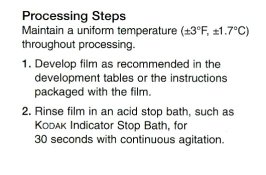Surprisingly, I find all these concepts quite simple and clear, even when I haven't done much work around them. I feel that many people are searching for debates and almost religious arguments instead of using their own brain to think a little bit.
For instance; stop bath does not magically remove or clear or delete developing agents. Water does not either. Acid only helps to maintain the pH of fixer. OTOH, two or three rinses, let alone the usually recommended four rinses, dilute the alkali of developer so low that it will not be a problem anymore. We can see that Ilford has a recommendation that 4 wash cycles could be enough even for
final wash -- we don't need to believe this completely now, but we can deduce that 4 wash cycles between
developer and fixer should really be more than enough - especially because after developer there are no silver-thiosulphate complexes to wash out and the pH is higher, allowing more rapid washing.
Then there's the argument of temperatures. So, you make your stop bath beforehand and let it sit on the shelf, so it's at room temperature. Why in the world can't you do this with water? You need around 1 to 2 liters, not a problem.
Then there's the best argument ever, "false economy", or "don't try to save". This argument is based on a concept that whenever there is any payment involved, the solution must be automatically better. So, stop bath is better than water because you have to pay for it, and you can prove this by saying: "using water is false economy. Stop bath is cheap." A variation of this theme is that stop bath is "designed" for the job. It does not mean that water isn't designed for the job, too. Oh well, water was available before there was film, but so was acid

. Anyway, stop bathes are manufactured for two reasons; 1) there are situations where they can be much better than water (but the usual small-tank BW film development with most films and developers is not one of them), 2) there are people out there who want to use it even when it's not necessary.
But, what if using just one stop bath was worse than using 3 or 4 changes of water? I can argue that using just stop bath will result in more than 1000 times higher developer contamination in fixer than 4 changes of water. If I use stop bath, I always use one extra water rinse after it. That means two steps. If I use just water, I use at least three steps. Just one step more. Both need water to be tempered to process temperature. Even just the stop bath does. So is there really something so favorable in stop bath? It does the job, just like water does. Both of them work perfectly!
So, no real difference here. This is a matter of taste. I just really don't find any need for stop bath for
film. Your mileage may vary

.








 . Anyway, stop bathes are manufactured for two reasons; 1) there are situations where they can be much better than water (but the usual small-tank BW film development with most films and developers is not one of them), 2) there are people out there who want to use it even when it's not necessary.
. Anyway, stop bathes are manufactured for two reasons; 1) there are situations where they can be much better than water (but the usual small-tank BW film development with most films and developers is not one of them), 2) there are people out there who want to use it even when it's not necessary. .
.




 . It seems that everyone accepts that for film, BOTH are accepted methods. In some instructions, only one of them is mentioned, in some instructions they are in different order than in others.
. It seems that everyone accepts that for film, BOTH are accepted methods. In some instructions, only one of them is mentioned, in some instructions they are in different order than in others.